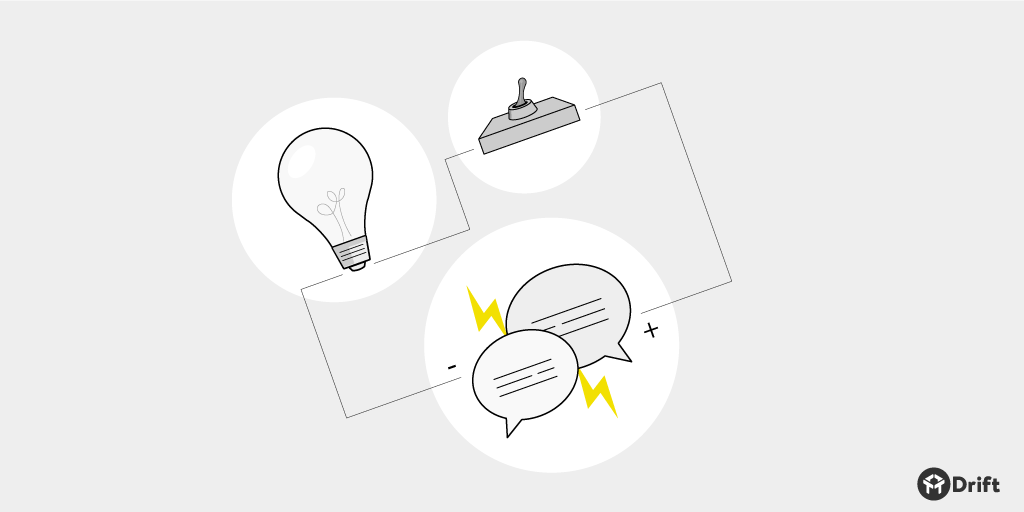
Customer feedback is the battery that powers customer-driven companies.
It has a positive side (e.g. praise for your product, or a high NPS score), as well as a negative side (e.g. someone telling you your product stinks). But just like with an actual battery, you need the positive and the negative in order for customer feedback to work.
The problem that many companies are facing right now, however, is that they simply don’t how to do customer feedback. They don’t know where to start. They don’t know how to flip that switch and begin the process of continually collecting and prioritizing what customers are telling them.
Whether your company falls into the category above, or you’re trying to figure out how to manage customer feedback more effectively, we’ve got you covered.
In this post, we’re going to walk you through the entire Drift customer feedback playbook, from why we value customer feedback so much, to how we gather it, to what we do with it once we have it.
But before we dive in, I’m going to provide a quick definition of customer feedback just to make sure we’re all starting out on the same page. (Use the nagivation links below if you want to skip ahead)
- Intro: Customer Feedback, Defined
- Part 1: Why Customer Feedback Matters
- Part 2: How to Ask for Customer Feedback
- Part 3: What to Do With Customer Feedback Once You Have It
Customer Feedback, Defined
Customer feedback refers to the opinions customers share with you about your product, service, and/or the overall experience they’re having with your business.
Whether it happens in-person, over the phone, via email, via an NPS survey, or via live chat, any time you hear directly from customers about how satisfied (or dissatisfied) they are, you’re dealing with customer feedback.
Ideally, customer feedback should be part of a continuous loop: You hear feedback about your product, you make improvements based on that feedback. Then you hear more feedback about your product, and you make more improvements based on that feedback. And so on.
Whether it’s positive feedback or negative feedback, all customer feedback should become part of this never-ending cycle of improving your product and improving the experiences customers are having.
But why should you listen to your customers in the first place?
Why should your customers help guide the direction of your product?
After all, as Henry Ford once famously said (or maybe didn’t say):
If I had asked people what they wanted, they would have said faster horses.
So, why listen to customers when you could just listen to the ideas and opinions of your company’s resident product visionary? That approach seemed to work out OK for our old pal Henry, right?
Not so fast.
1. Why Customer Feedback Matters
The forgotten chapter of the Henry Ford story is that his failure to listen to his customers almost led to the Ford Motor Company’s collapse.
Yes, the Model T changed the game … when it debuted in 1908. But by the 1920s, customer attitudes had shifted. People now wanted to buy cars that fit their individual lifestyles, and Ford’s competitors were happy to oblige them.
Henry, however, was laser-focused on producing his one-size-fits-all Model T. Instead of listening to what his customers wanted, he stuck to his original vision of producing a single, low-cost car.
As a result, the Ford Motor Company sold just 15% of the cars it manufactured in 1927, down from 60% in 1921.
1927 was the same year, not coincidentally, that Ford finally retired the Model T and unveiled a more modern car: the Model A.
Here’s how author and entrepreneur Patrick Vlaskovits described the situation in an article for HBR:
[Ford’s] tone-deafness to customers’ needs (explicit or implicit), had a very costly and negative impact on the Ford Motor Company’s investors, employees, and customers … It was clear what people wanted, and it wasn’t faster horses. It was better cars, with better financing options. I attribute Ford’s failure to respond in a timely and effective manner to competitive innovation in the marketplace to an attitude summed up in a quote he never uttered.
Lego is another company that almost lost it all as a result of “tone-deafness to customers’ needs.”
But unlike the Ford Motor Company, which failed to innovate as the needs of customers shifted, Lego had the opposite problem: they made radical product changes that customers never asked for.
It started in the ‘80s and ‘90s, when Lego replaced many of its veteran designers with recent graduates from some of the world’s top design schools. These new designers moved away from the simple bricks that made Lego famous and started adding more complexity to the product. As a result, the number of unique parts Lego was manufacturing soon skyrocketed from 6,000 to more than 12,000.
Sales, meanwhile, began to plummet. Customers clearly weren’t responding positively to the new, more intricate designs, many of which didn’t require much (if any) actual building.
It all came to a head in 2003, when Lego lost a whopping $300 million.
Their forecast for the following year? A loss of $400 million.
Fortunately for Lego, a new CEO — Jorgen Vig Knudstorp — came aboard in 2004, and he did something that Lego’s top execs had failed to do for decades: He asked the customers what they wanted. And he created design workshops and other programs that brought customers into the fold.
Knudstorp led a charge to put creative control into the hands of hardcore fans of the brand rather than in those of top designers who had skills but lacked a real understanding of Lego’s history.
Turns out (and this probably won’t come as a huge surprise), people love Lego because it allows them to build, and it allows them to express their creativity. Lego customers didn’t want to have a finished product handed to them, they wanted to build it themselves.
So, how has Lego been doing since changing their focus? In 2010, they reported $2.3 billion in annual sales. In 2015, they did $5.2 billion in sales.
The takeaway from both the Ford story and the Lego story:
Whoever gets closest to the customer wins.
Whoever does the best job of listening to customers, and understanding customers, and reflecting that understanding in the product is going to win market share.
When companies stop listening to customers, and when they start relying more heavily on the opinions of internal stakeholders, their products inevitably suffer.
And then guess what happens? A competitor comes along who is listening and builds the product people are actually asking for. It happens all the time.
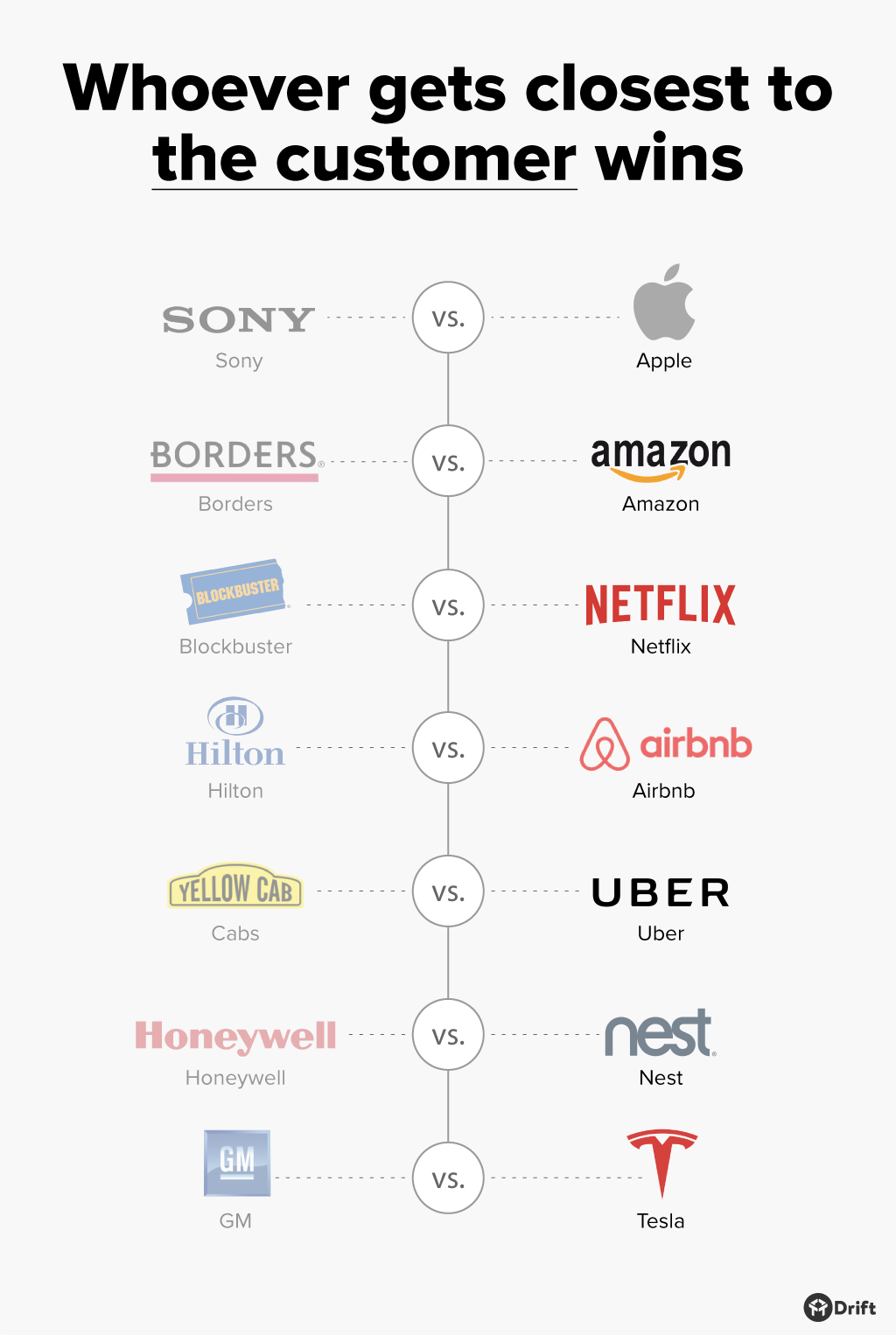
Ultimately, when your company’s vision for the product doesn’t reflect the reality of what customers want, you’re leaving the door wide open for competitors to build something better.
By establishing a customer feedback loop, and continually iterating based on what you learn, you can ensure your product is always the most desirable option on the market.
The benefits of customer feedback, however, can go well beyond product improvements.
By regularly engaging with and listening to customers, you can help improve customer satisfaction and help reduce churn.
Remember, in order to stop churn, you first need to understand the reasons behind why your customers are leaving. And in order to do that, you need to be communicating with customers directly.
Customer success metrics, while certainly important to measure, will only give you a quantitative view of what’s happening. In order to get a qualitative view, in order to truly understand the finer details and nuances of how customers are feeling, you need to make customer feedback a priority.
2. How to Ask for Customer Feedback
Arguably, there are as many ways to gather customer feedback as there are communication channels.
I mean, if you were so inclined, you could gather customer feedback via a fax machine, or a telegraph, or walkie talkies (that last one sounds kind of fun actually).
But for the purposes of this post, we’re going to hone in on the customer feedback channels that we think make the most sense for modern SaaS companies.
Welcome Email
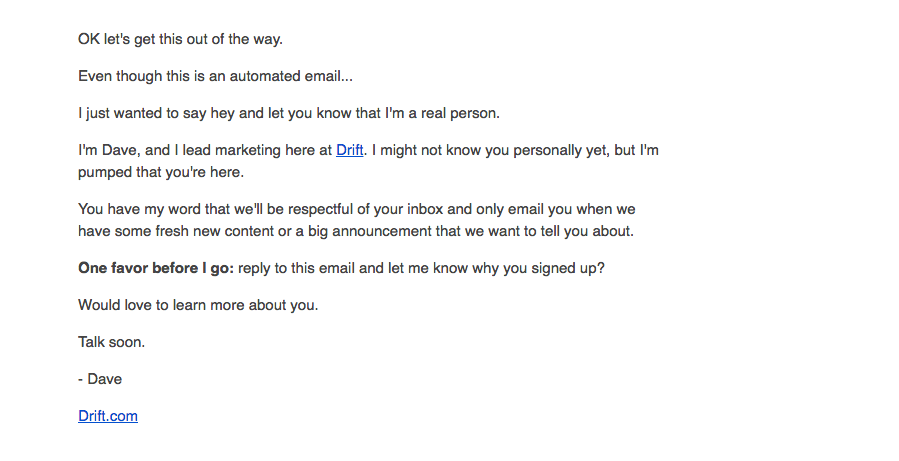
At Drift, we believe that the welcome email (like the one you see above) is the single most important email you can send.
Why? Because when people are brand new to your business — whether they’ve just become a customer, or a free user, or a newsletter subscriber — that’s when they’re the most engaged. It’s a great opportunity for soliciting feedback.
Remember, these folks have just put their hands up and said, “Hey, I want to be a part of this.”
Your welcome email should, of course, remind those folks of the value they’ll be getting now that they’ve signed up. But even more importantly, your welcome email should help give you insight into why those people decided to join you in the first place.
The best way to glean those kinds of insights: Ask a question.
Here are a few examples of questions you might include in a welcome email.
- Why did you sign up?
- What are you looking to accomplish?
- What have you been struggling with?
For best results, stick to asking a single question. The more you ask of people, the less engagement you’re likely to get.
At Drift, we read every single response we get from our welcome emails. Every. Single. One.
And considering that our newsletter welcome email, for example, has a 75% open rate and a 25% response rate, that’s actually a decent amount of responses to pore through.
Far from being a waste of time, gathering feedback via welcome emails has helped us identify areas for improvement both in our marketing and our product (especially in our onboarding flow).
Click here to see all of the emails we send at Drift.
Live Chat

For years now, traditional sales and marketing wisdom has told us that in order to succeed, you need to be having the right conversations, with the right people people, at the right time.
But in practice, instead of letting people talk to us at the right time (e.g. when they’re on our websites, or inside of our apps), we’ve been forcing them to fill out forms.
Instead of engaging people right then and there, when they’re ready to engage, we’ve been saying, “Oh, hey, you’re interested? That’s great. But before I let you talk to an actual human, check your inbox. I just sent you 37 emails.”
Thankfully, live chat has arrived.
In addition to flipping the traditional sales and marketing model on its head, live chat is revolutionizing how customer support and customer success teams operate.
Under the old model, when you had an issue with a product, or a suggestion, or any kind of feedback to share, you submitted a support ticket. And maybe you’d get an email back in a few days … or a few weeks. But in lots of cases, you wouldn’t hear anything.
Then, one day, maybe your issue would get resolved. (But then again, maybe it wouldn’t.)
Live chat eliminates this terrible customer experience and replaces it with a mode of communication that billions of people have already adopted: 1:1 messaging.
By setting up a live chat widget on your site, you’re letting people know that you’re open for business and always ready to talk.
At Drift, we have everyone at the company take shifts managing our live chat so everyone has the opportunity to interact 1:1 with our site visitors, free users, and paying customers.
The ability to assign conversations to particular coworkers makes it easy to manage incoming chats. And by controlling conversation statuses (e.g. Open, Pending, Closed) and custom tags (e.g. Lead, Customer, Super-Fan), even marketers like me can stay organized.
Click here to learn more about our live chat solution.
In-App Messages
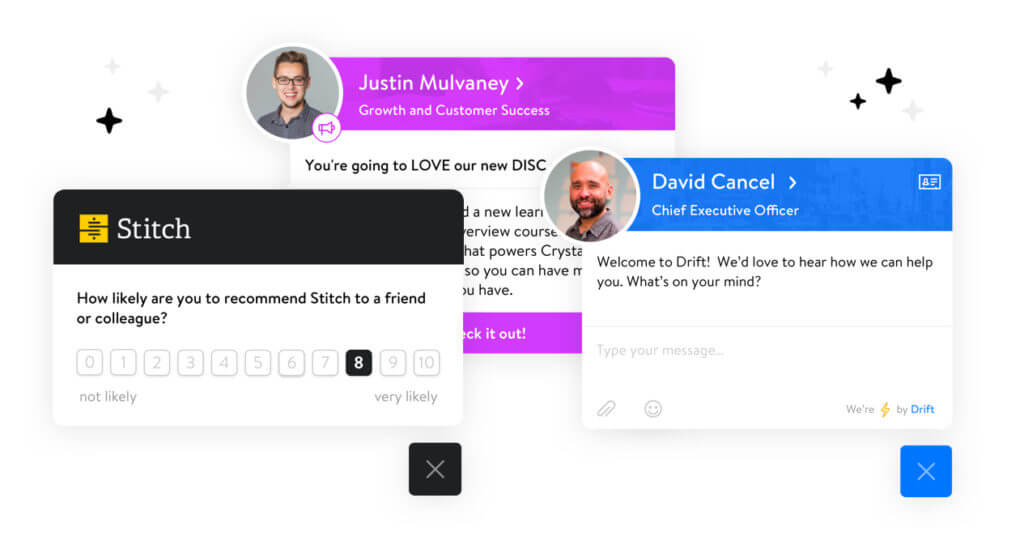
Of course, live chat doesn’t have to be limited to your website.
In-app messages give you the same functionality as live chat but places it inside of your actual product. That way, customers can quickly and easily reach out as soon as they encounter an issue directly from where they are encountering it. (It’s your ultimate right place, right time, scenario.)
Without live chat, customers are stuck dialing into support via telephone — an experience that most people don’t look forward to.
Here’s how Drift’s head of marketing, Dave Gerhardt, explains it:
Put your consumer hat on for a second. If you’re thinking about buying something or you’re stuck inside of a product that you use, do you want to pick up the phone and talk to someone? In most cases, the answer is no. And your customers and prospects don’t want to pick up the phone either.
In addition to reducing the need for (annoying) telephone calls, in-app messages can also help you reduce the number of emails you’re sending out.
Consider this statistic: the average email open rate for emails sent by SaaS companies is just north of 20%. Meanwhile, the average engagement rate for in-app messages is north of 40%. (And with the help of targeting and customer triggers, you can drive those engagement rates even higher.)
At Drift, we typically use in-app messages to announce new features directly to customers who are in a particular part of our app, as well as to target free users and help them along the path to becoming paying customers (assuming they’re a good fit for a paid plan).
We also use in-app messages for conducting Net Promoter Score (NPS) surveys, which we’ll cover in the next section.
Click here to learn more about our in-app messages.
Net Promoter Score (NPS)
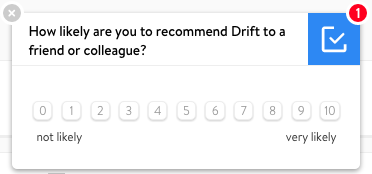
NPS is one of the most popular SaaS metrics for measuring customer satisfaction.
An NPS survey asks a single question: “How likely are you to recommend [Product] to a friend or colleague?”
Responses fall along a 0-10 scale, with 0 meaning a customer isn’t likely to recommend the product, and 10 meaning a customer is very likely to recommend the product.
To calculate your product’s overall NPS, you first need to group survey responses into three categories:
- 0-6 = detractors
- 7 or 8 = passives
- 9 or 10 = promoters
Next, you need to subtract the percentage of customers who are “detractors” from the percentage of customers who are “promoters.” (You can ignore the “passives”.) The resulting number is your NPS.
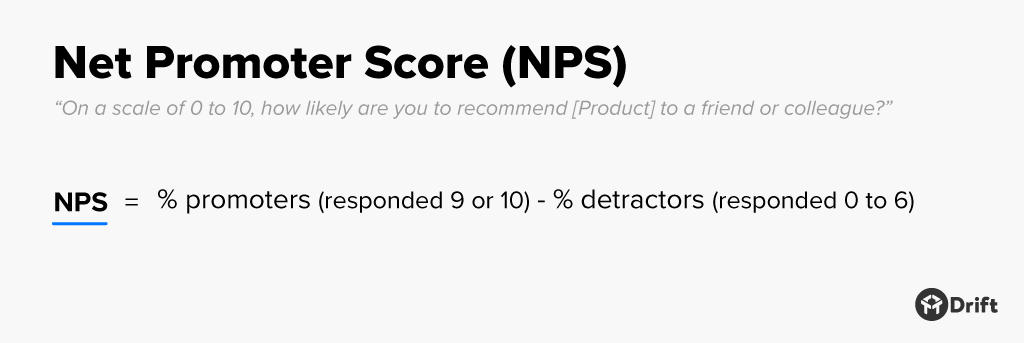
For example, let’s say you have 10 customers take the survey. If you end up with 2 detractors, 3 passives, and 5 promoters, your NPS would be 30. Because you’d subtract the detractors — 20% of respondents — from the promoters — 50% respondents — and get 30%. (Then just drop the %, because NPS is always written as an integer.)
As a rule of thumb, an NPS of 50 is considered decent.
(But for perspective, Apple’s NPS is 89.)
Just Ask
Here’s one final (and incredibly simple) tactic for gathering customer feedback: Just ask.
Whether it’s an email, a phone call, or an in-person chat over a cup of coffee, take the time to ask customers directly for their thoughts and opinions.
The worst case scenario: customers are too busy to talk and ignore you (womp womp). The best case scenario? You unearth some incredibly valuable feedback that helps you take you product to the next level.
As Wayne Gretzky once said,
You miss out on 100% of the feedback you don’t ask for.*
(*Note: I may have taken a few artistic liberties with this quote.)
3. What to Do With Customer Feedback Once You Have It
Let’s assume you’ve successfully flipped the customer feedback switch, and you now have a steady stream of feedback flowing in through a variety of channels.
You might be tempted to think that your work here is done … but it’s actually only just beginning.
In order to complete the circuit, in order to have customer feedback truly power your business, you need to do something with that feedback. You need to make it actionable.
Of course, when you have boatloads of feedback coming in on a regular basis — some of it about bugs and other product issues, some of it about features people want you to add — making it all actionable can be easier said than done.
How do you organize and prioritize the different types of customer feedback you’re hearing? How do you know what feedback you should be focusing on and what feedback you should be ignoring?
The Spotlight Framework
At Drift, we start by using our CEO David Cancel’s Spotlight Framework to categorize all of the feedback we’re gathering.
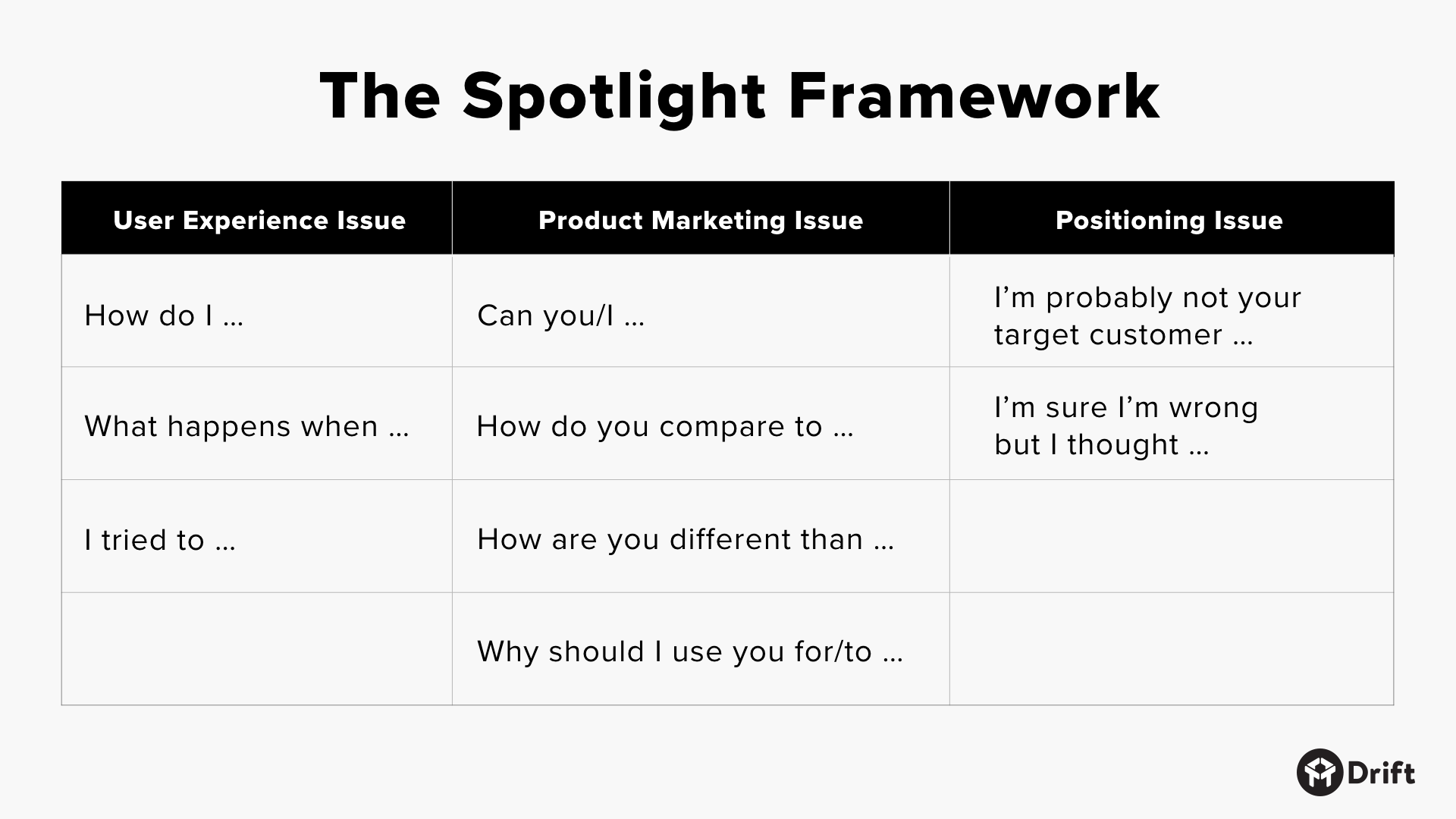
The key to using the framework is to focus on the opening words and phrases of the feedback you’re hearing. You’ll then be able to diagnose the underlying issues you’re dealing with so you can take the appropriate actions to resolve them.
Here are the three buckets most feedback will fit into:
- user experience issues (e.g. “How do I turn on this feature?”),
- product marketing issues (e.g. “Can you integrate with this platform?”),
- positioning issues (e.g. “I’m probably not your target customer, but I was wondering if your product can help me do this …”).
If you want to start using the Spotlight Framework at your company, a simple Excel doc or Google Sheet will do. Just enter feedback into the right categories as you’re gathering it. Then, once a week, or once every two weeks, you can go through your doc, identify the top issues for each category, and assign folks to resolve those issues.
(FYI: At Drift, we also use our messaging software to “tag” live chat and in-app conversations as either user experience, product marketing, or positioning issues.)
Ultimately, when you keep all of the feedback you’ve gathered in one big pile, it can be hard to pick out what’s important. By separating it out into these three categories, you can make sure you’re coming up with solutions that address the root causes of the issues at hand.
Feedback From Free Users vs. Paying Customers
When gathering feedback, you need to take into account not only what is being said, but also who is saying it.
This is especially the case for SaaS companies (like us) that use freemium sales models. Because when you have tons of free users in addition to paying customers, figuring out who to listen to can get tricky.
Our CTO Elias Torres has been grappling with this issue for years, and he recently came up with a methodology for dealing with feature requests from free users vs. paying customers.

One of Elias’s sticking points here is that your paying customers are the closest to your product, so their opinions and concerns need to be weighted more heavily.
Your paying customers are the ones using your product day-in, day-out, and they’re the ones who have found so much value in your product that they’re willing to pay for it. (And in many cases, they’re happy to pay for it because of that value it’s delivering.)
Free users, on the other hand, are often just testing the waters and seeing if you’d be a good fit.
If we look back at the Spotlight Framework, feedback from free users tends to fall in the product marketing category. These folks are still trying to figure out what you can do, so they’re asking questions like, “Do you integrate with this?” and “Can I host this myself?”
Paying customers, meanwhile, tend to give feedback that falls into the user experience category. They already know what you can do, but now they want you to make things faster, or easier.
That’s not to say, however, that requests and other feedback from free users should be ignored. Even if you have to say “no” to a request, you don’t have to end the conversation at a “no.” Keep asking questions.
You should treat every conversation you have as an opportunity to learn.




